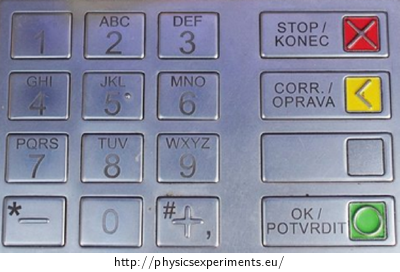Heat Traces Around Us
Experiment number : 4345
Goal of experiment
This simple experiment (or perhaps more accurately a set of experiments) aims to show heat traces that we, humans, leave behind in our environment.
Theory
The commonly reported average internal temperature of the human body is around 37 °C – for example, the English Wikipedia refers to values in the range of 36.1 °C to 37.8 °C as “normal temperature”. However, we can measure widely varying surface temperatures on different parts of the body – especially on the parts that are far from the core, such as the fingertips, the measured values may be noticeably lower. In addition, other factors come into play – e.g. time of day or purely individual effects (current state of health, etc.). In any case, the surface temperature of the human body is usually higher than the room temperature, so that when we come into contact with room temperature objects, they are heated up due to heat exchange.
It is easy to detect such temperature increase in the case when the object is a thermal insulator. The temperature increase is only noticeable at the point of contact with the human body, it is clearly localized and a distinct thermal trace is produced. In the case of good heat conductors, the situation is less straightforward – the heat is immediately distributed from the point of contact to the entire volume of the conductor. Thus, if the contact is short and the amount of heat exchanged is small, the heating of the body as a whole may be almost unmeasurable. A secondary goal of the experiment may therefore be to qualitatively distinguish between thermal conductors and insulators according to the way in which they dissipate heat.
Equipment
Thermal imaging camera, other objects of your choice (in the sample experiment, a keyboard was used).
Procedure
The experiment can take very different forms, so a standardized procedure is not given. In general, suggestions can be given for phenomena that can be observed with a thermal imaging camera – for example, the following situations can be considered:
thermal palm prints on a thermally conductive and thermally insulating surface; this idea is developed in more detail in the experiment Thermal Conductivity of Plastic and Metal I.
analogy of the previous experiment with footprints
heat imprints on a chair that someone has just got up from, or on a wall that someone has been leaning against
heat marks on the handle of a recently opened door, on taps, on a recently put away book, on a plastic bottle that has been recently drunk from, etc.
heat traces on the currently used computer mouse or keyboard (this option is demonstrated in the Sample result section)
many other ideas...
Sample result
The sample experiment deals with a keyboard. It can be seen that there are significant heat prints on the used keys that are visible for up to several seconds. Using a thermal imaging camera, we can also read the letters that were used (and possibly in the right order). The sample video shows this effect on the word SVETR – the Czech word for sweather.
The FLIR i7 thermal imaging camera was used when making this video. The temperature range of the colour scheme was chosen in the interval 22 °C to 28 °C, the emissivity was ε = 0.95.
Pedagogical note regarding the sample result with keyboard
The question arises whether it is possible to abuse a similar principle and use a thermal imaging camera to detect, for example, a PIN code entered on the ATM keypad when withdrawing cash, etc. It turns out, however, that ATMs typically have keypads made of metal (Figure 1) and the heat supplied by the finger is thus immediately distributed to the surrounding area upon touch. It is therefore impossible to identify any thermal history on the ATM keypad with FLIRi7 thermal imaging camera. If we want to demonstrate this fact without leaving the classroom, any metal object can be used as a substitute for the ATM keypad.

With non-metallic surfaces, however, the theft of login credentials using thermal imaging can indeed be a real threat – the following YouTube video illustrates this very clearly:
Thermal imaging camera basics - link to PDF
In this experiment, a thermographic measurement is used. The theory of thermography and basic recommendation and procedures that can help you obtain more accurate and undistorted results can be found in Experiments with thermal imaging camera (in Czech only).








